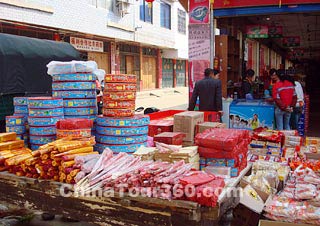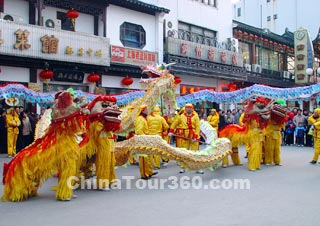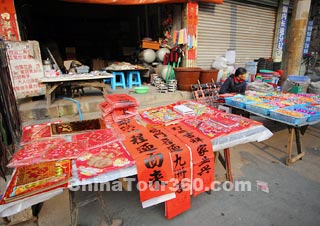Date: The first day of the year in the lunar calendar. This is usually in late January or early February.
Place: Nationwide
Activities: Fireworks display, visiting and greeting family and friends, eating dumplings, Yangge dancing, lion and dragon dancing, temple fairs, and many other celebrations of Chinese folklore.
 |
| Firecrackers of Spring Festival |
|
 |
| Lion Dancing during Spring Festival |
|
The Spring Festival, also known as Chinese New Year to the westerners, is celebrated by Chinese throughout the world. Wherever one finds large Chinese communities, one finds large celebrations. It is the most important festival in China. Beginning the first day of the lunar year, the celebration usually lasts for weeks. Actually most Chinese people started to prepare for the festival nearly one month before the New Year Eve. They will cook, clean the houses, wash clothes, buy fireworks, decorate houses, buy new clothes and visit family and friends.
Before the event, houses are thoroughly cleaned. Everyone gets a haircut and purchases new clothes. People burn incense at home and in the temples to pay respects to ancestors and to pray for good health, peace, and luck in the coming year. Red lanterns are hung everywhere. Red scrolls with complementary poetic couplets are pasted at every gate, one line on each side of the gate. Red paper-cuttings and the Chinese character for lucky are also pasted on windows or doors. On New Year's Eve, families have a reunion feast of jiaozi (dumplings) and niangao (a kind of sticky rice cake), and then stay up and talk through the night, talking about the past and the future. Now most Chinese family will get together and watch the Spring Festival Gala held by the CCTV at the New Years Eve.
 |
| Couplets of Spring Festival |
|
 |
| Spring Festival Food, Chinese Dumplings |
|
When the clock rings to announce the arrival of the New Year, many households set off fireworks at almost the same time, creating a thunderous roar and clouds of smoke. This ceremonial use of fireworks is meant to send off the old and usher in the new.
Early the next morning and on the following days, everyone wears new clothes. People pay New Year visits to relatives and friends to extend the New Year's greetings. Childrens get the new year lucky money from their parents and other older family members. Cities, rural towns, and villages present waist drum displays, Yangge dancing, lion and dragon dancing, and other folk dances. There are other grand celebrations, such as the Temple Fairs.
Yangge dancing originated 2,000 years ago as a religious activity to greet the Gods and dispel evil, but is now a recreational activity during the sowing season and on holidays. It is especially popular among the northern Han.











